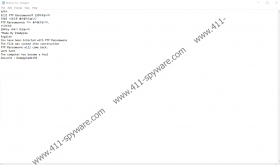PTP Ransomware Removal Guide
PTP Ransomware is a random infection that might be dangerous if it were developed properly. However, it seems that whoever came up with this program didn’t think things through. As far as we know, PTP Ransomware cannot even encrypt target files, although it is programmed to do so. Therefore, if you see this program on your computer, you can remove PTP Ransomware without much remorse. Simply follow the manual removal instructions below this description to get rid of this infection. For more comprehensive computer security, do not hesitate to invest in a legitimate antispyware tool.
The point is that we have seen multiple programs like this one before. That is so because PTP Ransomware is based on the Hidden Tear ransomware code. Perhaps the most infamous program that is based on the Hidden Tear code is GandCrab Ransomware, which is still terrorizing users here and there. The point is that Hidden Tear is an open-source ransomware program. It means that the code is available for the public, as long as people know how to acquire it and how to use it. And you can be sure that cybercriminals would definitely know how to tweak the original code to their own liking.
Thus, PTP Ransomware is very similar to BSS Ransomware, SnowPicnic Ransomware, EnybenyCrypt Ransomware, and many others. They all will share the same distribution methods and similar behavioral patterns, but some will be weaker than the others. PTP Ransomware clearly falls into the “weaker” category, as it cannot even encrypt your files. That is definitely a good thing because it saves you the trouble of going through all sorts of file recovery options. But we should also remember that you could always get infected with a ransomware program that COULD encrypt your files, so you need to learn how to recognize a potential ransomware installer.
Ransomware is usually distributed via spam email messages. They come with spam email attachments. Sometimes you might also receive ransomware installers through corrupted RDP (Remote Desktop Protocol) connections. Either way, the point is that you are the one who opens the dangerous file, so you have to be careful about the files you receive from unknown senders. We do understand that these files can look like legitimate documents, but that shouldn’t be the reason for you to open them. If you must, you can scan these files with a security tool just to make sure they are safe.
Now, as far as PTP Ransomware is concerned, this ransomware is supposed to encrypt an entire galore of file types. However, it mostly targets one directory: the program creates a new folder on your Desktop, names it “test” and tries encrypting the files there. After that, it displays a ransom note in Korean, that says your files have been sucked into the voice, and it doesn’t even tell you how to recover your files (well, that is because you do not need to recover anything). However, we still have to consider this program a serious infection because it could be just a test run, and PTP Ransomware might always come back stronger and more dangerous.
This program has no point of execution, so it is not complicated to remove it manually. Simply delete the most recent files to remove PTP Ransomware for good. If you are not sure about your system’s security, you can scan your PC with a licensed antispyware tool that will help you determine if there are more dangerous programs on-board. Should more malware apps be found, terminate them automatically, and then safeguard your system against other potential threats that might try to enter your PC in the future.
How to Delete PTP Ransomware
- Delete the most recent files from Desktop.
- Go to the Downloads folder and delete the most recently downloaded files.
- Press Win+R and type %TEMP%. Click OK.
- Scan your PC with SpyHunter.
PTP Ransomware Screenshots:

PTP Ransomware technical info for manual removal:
Files Modified/Created on the system:
| # | File Name | File Size (Bytes) | File Hash |
|---|---|---|---|
| 1 | 8472e80c6d5efb33c3468ad5823157b3a95c2327cad5556cf8b0c30b9d7c7dd5.exe | 513536 bytes | MD5: 66c72c0c058bdee8b26c13d9dec072f3 |
Memory Processes Created:
| # | Process Name | Process Filename | Main module size |
|---|---|---|---|
| 1 | 8472e80c6d5efb33c3468ad5823157b3a95c2327cad5556cf8b0c30b9d7c7dd5.exe | 8472e80c6d5efb33c3468ad5823157b3a95c2327cad5556cf8b0c30b9d7c7dd5.exe | 513536 bytes |

